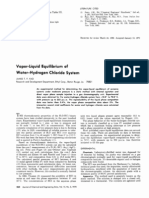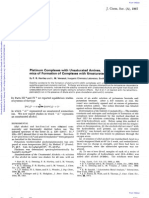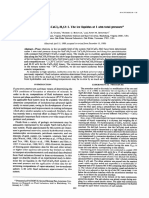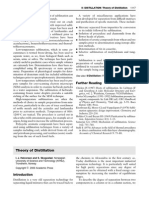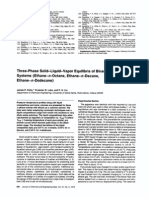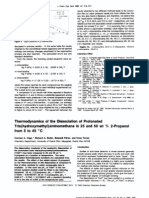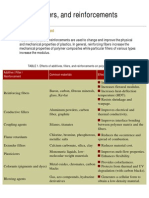Liquid Liquid Equilibrium
Liquid Liquid Equilibrium
Uploaded by
Lucas_ABCopyright:
Available Formats
Liquid Liquid Equilibrium
Liquid Liquid Equilibrium
Uploaded by
Lucas_ABOriginal Description:
Original Title
Copyright
Available Formats
Share this document
Did you find this document useful?
Is this content inappropriate?
Copyright:
Available Formats
Liquid Liquid Equilibrium
Liquid Liquid Equilibrium
Uploaded by
Lucas_ABCopyright:
Available Formats
CRITICAL PHENOMENA IN THE SYSTEM
ACETIC ACID - CHLOROFORM - WATER
A. N. CAMPBELL
AND E. M. KBRTZMARK
Department of Chemistry, University of Manitoba, Winnipeg, A!lanitoba
Can. J. Chem. Downloaded from www.nrcresearchpress.com by 177.34.162.29 on 04/17/16
For personal use only.
Received November 30. 1962
ABSTRACT
This paper is an experimental study of ( a ) the solid-liquid equilibria a t low temperatures;
(b) equilibrium compositions a t temperatures other than 25" C ; (c) the critical phenomena,
L1-L2, L1-V, and L2-V, in the acetic acid - chloroform -water system. No previous study
has been made of critical phenomena in a system exhibiting partial liquid miscibility.
The system acetic acid - chloroform - water is one of the classical examples of partial
miscibility in a ternary system, first studied by Wright, Thompson, and Leon in 1891
(1). Thanks t o the subsequent workers Brancker, Hunter, and Nash ( 2 ) , the equilibrium
relations a t 25" are very well known, as far as the compositions of equilibrium liquid
layers are concerned. Nothing, however, is known about:
(a) the solid-liquid equilibria a t low temperatures;
(b) equilibrium liquid compositions a t temperatures other than 25";
(c) the critical phenomena, L1-V (L1 = chloroform layer) and L2-V (Lz = aqueous
layer).
So far no study has been made of critical phenomena in any system exhibiting partial
miscibility in the liquid state and the results arrived a t in this paper have general applicability to all systems of this kind.
A previous paper (3) has dealt with the thermodynamics of this system, as exemplified
by the vapor pressures and densities. Further work is proceeding on the isobaric boiling
points, dielectric constants, and heats of mixing.
RESULTS AND DISCUSSION
Because of the chemical natures of the substances named in the title, formation of
compounds or of solid solutions is inherently improbable and therefore the study of the
freezing point curves was expected t o yield little of interest. The study was, however,
carried out for the binary systems chloroform - acetic acid and chloroform - water, and
for the ternary system, using a double-junction copper-constantan thermocouple, a Brown
Elektronik recorder, and liquid nitrogen as a coolant. The system acetic acid -water was
previously studied by various workers (4) and the eutectic found t o lie a t 58.1% acetic
acid and -28.5 t o -27.0'. The eutectic of the chloroform - acetic acid system was found
t o lie a t 91.8% CHCl3 by weight, and -67.5" (Fig. 1). In the system chloroform-water,
the eutectic lies a t O.lyo Hz0 and -64.0". The ternary eutectic was found to lie a t -70"
and 90.7% chloroform, 8.3% acetic acid, and 1.0% water. The eutectic trough leading
from the acetic acid -water eutectic to the acetic acid -chloroform eutectic was determined experimentally. The results are given in Fig. 2, on which has been superimposed
the partial miscibility gap for 0'.
Two types of temperatures of homogeneity are t o be distinguished in this work, namely,
the temperature a t which two partially miscible liquids become completely miscible
(L1 L2 --t L) and the true critical temperatures (L1 V -+ V and/or L2 V + V) ;
Canadian Journal of Chemistry. Volume 41 (1963)
Can. J. Chem. Downloaded from www.nrcresearchpress.com by 177.34.162.29 on 04/17/16
For personal use only.
CAMPBELL APZD KARTZMARK: CRITICAL PHENOMENA
FIG. 1. Freezing point diagram of system chloroform -acetic acid. Eutectic: -67.5" C, 91.8% CHC13.
FIG. 2 . 0' isotherm superimposed on a projection of the ternary freezing point diagram.
certain of the mixtures, though not all, will exhibit all three temperatures. For the determination of all three types of temperatures, the simple apparatus shown in the photograph
(Fig. 3) worked very well. I t consists essentially of a cylindrical block of copper, weighing
about 75 lb and having a radial boring of 1-cm diameter. Slots parallel t o the boring
permit light to pass through. A sealed capillary tube placed in the central boring can be
viewed in a telescope a t a safe distance. Two heating circuits in parallel, wound around
the copper cylinder, make i t possible t o raise the temperature to 350' in about 3 hours.
An ordinary mercury-in-glass thermometer placed in a separate boring of the copper
block gives the temperature. T h e temperature was corrected for exposed stem but with
Can. J. Chem. Downloaded from www.nrcresearchpress.com by 177.34.162.29 on 04/17/16
For personal use only.
1090
CANADIAN JOURNAL O F
CHEMISTRY. VOL.
41, 1963
FIG. 3. Apparatus.
.this relatively crude arrangement we do not believe the results to be more accurate
than +lo.We saw no reason to refine the temperature measurement, although it would
have been easy to do so. Temperature was easily controlled and occasional explosions
constituted no hazard to the operators.
A possible criticism of this method, as applied to L-V critical temperatures, is that,
unless the amount of the mixture and the volume of the container are such as to represent
the critical density, the temperature of disappearance of t h e meniscus is not the true
critical temperature. Nevertheless, the phenomena as observed usually presented the
fluctuating striae said to be characteristic of critical phenomena. I t is true that the
temperature of reappearance of the meniscus was frequently 5-10' lower than that of
disappearance but this may be a characteristic of mixtures as distinct from pure liquids:
we reproduce only the temperature of disappearance. The results were also reproducible
in different experiments and the curve of critical temperature vs. composition was smooth.
T h e explanation is, no doubt, t h a t in the four-dimensional representation of pressure,
volume, temperature, and concentration, all curves are very flat in the neighborhood of
the critical point, or, in plain words, the critical temperature is not very sensitive to
small changes in volume of the system. At all events, we repeat that in all cases the disappearance of the meniscus appeared to be a critical phenomenon: cases where the 111eniscus
disappeared by exhaustion of the one or other phase were always discarded. If our figures
are not true critical temperatures they are sufficiently close for the present purpose. We
note that the critical temperatures of the pure liquids as determined by us are in good
agreement with accepted literature values.
T h e critical temperatures of the homogeneous binary systems acetic acid - water and
acetic acid - chloroform are reproduced graphically in Figs. 4 and 5. The critical temperatures of homogeneous ternary mixtures are given in Table I, since they cannot be
expressed graphically on a plane diagram to any purpose.
Can. J. Chem. Downloaded from www.nrcresearchpress.com by 177.34.162.29 on 04/17/16
For personal use only.
CAMPBELL A N D KARTZMARK: CRITICAL P H E N O M E N A
W t % CHCI,
FIG. 4. Acetic acid - water critical temperatures.
FIG. 5. Chloroform - acetic acid critical temperatures.
TABLE I
Composition of mixture in wt%
Acetic acid
Water
Chloroform
Critical temperature
in OC
Can. J. Chem. Downloaded from www.nrcresearchpress.com by 177.34.162.29 on 04/17/16
For personal use only.
1092
CANADIAN JOURNAL O F
CHEMISTRY. VOL. 41.
1963
Within the region of heterogeneity, as mentioned in the introduction, two, and sometimes three, temperatures of homogeneity (2 phase) have t o be determined. The
L1 - L2 -+ L temperature was easily determined in the apparatus described as the temperature a t which one or the other liquid layer vanished by exhaustion (method of
Alexejew). In order to do this accurately, it is necessary to heat very slowly in the neighborhood of the temperature of homogeneity, t o remove the tube and shalile vigorously
t o produce a fine suspension, and then to determine if the suspension persists a t the
temperature of the furnace.
As a preliminary to the above work, however, the isothermal area of heterogeneity
was determined a t such temperatures as were readily accessible, viz. 0, 48.5', and 91.5".
Such quantities of the three components as would give approximately equal volumes of
the two layers were stirred in thermostat for 24 hours and then each layer sampled for
analysis. The method of analysis was that of determining acetic acid by titration. A
weighed amount of acetic acid was then added to a separate sample and the density
determined. A previous calibration had been made, a t 25', of the densities of mixtures
lying without the area of heterogeneity (3). These data yielded a complete analysis. We
have subsequently found that the determination of refractive index gives a more sensitive
determination. The results are represented graphically in Figs. 6, 7, and 8. The plait
point compositions are given in Table 11.
T A B L E I1
Composition in wt%
Temperature in O C
0
25.0 (Brancker. Hunter
a n d Nash (2))
48.5
91.5
Chloroform
Water
Acetic acid
45.0
14.0
41 .O
The results of the Alexejew method for the heterogeneous region are represented
graphically in Figs. 9, 10, 11, 12, and 13, each of which represents a pseudobinary section
of the solid model having a fixed amount of acetic acid. Some comment is necessary. In
systems containing less than 20y0 acetic acid, the surface of heterogeneity (L1-L2)
intersects the critical surface L1-V, where L1 represents the chloroform layer. This
means that the chloroform layer has a constant composition when passing through the
critical change Ll-V, and this change therefore takes place a t a constant temperature,
independent of the total composition, so long as the composition lies within the miscibility
gap a t the temperature of the L1-V transition. The L1-V transition exhibits experimentally
all the characteristics of a true critical point, except that a (separate) liquid layer, the
aqueous layer, remains behind and this in turn goes through the L2-V critical transition
a t , however, a much higher temperature. Since, however, there is only one liquid, its
composition varies with the total composition of the mixture and therefore the second
critical temperature (Lz-V) is not constant but is a function of total composition.
As the concen-tration of acetic acid in the pseudobinary mixtures is increased, the Ll-L2
surface separates from the L-V surface and the temperatures of L-V transition now also
become a function of total composition. This is clearly shown in the pseudobinary
sections Figs. 9, 10, 11, 12, and 13.
CAMPBELL AND KARTZMARK: CRITICAL PHENOMESA
Can. J. Chem. Downloaded from www.nrcresearchpress.com by 177.34.162.29 on 04/17/16
For personal use only.
Acetic Acid
FIG.6. 0' C isotherm.
FIG.7. 48.5' C isotherm.
FIG.8. 91.5" C isotherm.
Can. J. Chem. Downloaded from www.nrcresearchpress.com by 177.34.162.29 on 04/17/16
For personal use only.
CANADIAN JOURNAL O F CHEMISTRY. VOL. 41. 1963
WtSb CHCI,
FIG.9. Critical d a t a in system chloroform-water.
FIG. 10. Critical data in pseudobinary system containing
lOy0 acetic acid.
CAMPBELL AND KARTZMARK: CRITICAL PHENOMENA
400-
Can. J. Chem. Downloaded from www.nrcresearchpress.com by 177.34.162.29 on 04/17/16
For personal use only.
20% A c e t i c A c i d
Wt% CHCI,
30% A c e t i c A c i d
W t % CHCI,
Fig. 11. Critical data in pseudobinary system containing 20% acetic acid.
FIG.12. Critical data in pseudobinary system containing 30y0 acetic acid.
CANADIAN JOURNAL O F
CHEMISTRY. VOL. 41,
1963
40% Acetic Acid
Can. J. Chem. Downloaded from www.nrcresearchpress.com by 177.34.162.29 on 04/17/16
For personal use only.
300
O
\
- --- - - - - - -
FIG. 13. Critical data in pseudobinary system containing 40% acetic acid.
From the data given it is readily possible to construct the solid (composition-temperature) model, on an equilateral triangular base, and we have done this as an aid to the
teaching of advanced phase rule. The experimental data of this paper are available on
-application.
REFERENCES
1. C. R.A. \\'RIGHT,C. THOMPSOK,
and J. T. LEON. Proc. Roy. Soc. (London), 49, 174 (1891).
2 . A. V. BRANCKER,
T. G. HUNTER,
and A. mT. NASH. J . Phys. Chem. 44,683 (1940).
3. A. N. CAMPBELL,
E. KARTZMARK,
and J. M. T. M. GIESKES. Can. J. Chem. 41, 407 (1963).
4. A. FAUCON.Ann. Chim. Phys. 19, 70 (1910). M. HIRATA,Y. HIROSE,and K. KOBAYASHI.Kagaku
Kagaku, 23, 403 (1959).
You might also like
- Exp 6 Phase Equilibrium Eutectic SystemDocument6 pagesExp 6 Phase Equilibrium Eutectic SystemNur Fadhilah33% (3)
- Index To PTSDocument47 pagesIndex To PTSpolaris44100% (7)
- Alt SpecsDocument82 pagesAlt SpecsrozleNo ratings yet
- Kinetics of Catalytic Dehydrogenation of Ethylbenzene To StyreneDocument5 pagesKinetics of Catalytic Dehydrogenation of Ethylbenzene To Styreneibrahim3318No ratings yet
- Vle of Hcl-WaterDocument6 pagesVle of Hcl-WaterYaqoob Ali0% (1)
- Theory of Thermal IgnitionDocument60 pagesTheory of Thermal IgnitionDayasagar VSNo ratings yet
- Ternary Phase DiagramDocument9 pagesTernary Phase DiagramFabiha SheikhNo ratings yet
- Equilibrium Data - Water and Acetic Acid, Water and Methanol, and Water and EthanolDocument6 pagesEquilibrium Data - Water and Acetic Acid, Water and Methanol, and Water and EthanolBarbara RicciNo ratings yet
- Vapor-Liquid Equilibria, Densities, and Refractivities in The System Acetic Acid Chloroform - Water at CDocument23 pagesVapor-Liquid Equilibria, Densities, and Refractivities in The System Acetic Acid Chloroform - Water at CMc Jason LaureteNo ratings yet
- MT Lab Final RecordDocument85 pagesMT Lab Final RecordPRABATH MADHAVANNo ratings yet
- A Correlation For Three-Phase Behavior of Cationic Surfactant-Oil-Water SystemsDocument17 pagesA Correlation For Three-Phase Behavior of Cationic Surfactant-Oil-Water SystemsbarretoquinterocdNo ratings yet
- Carbon Dioxide,+ (O-Cresol, P-Cresol and Ethanol) PDFDocument27 pagesCarbon Dioxide,+ (O-Cresol, P-Cresol and Ethanol) PDFJosé IvánNo ratings yet
- Lemkowitz 2007Document17 pagesLemkowitz 2007juliomilitaoNo ratings yet
- BSL2Document7 pagesBSL2Kevin CruzNo ratings yet
- Equilibrium Constants Methyl Tert-Butyl Ether Liquid-Phase SynthesisDocument5 pagesEquilibrium Constants Methyl Tert-Butyl Ether Liquid-Phase Synthesisjulior87No ratings yet
- Phase Diagram of A Three-Component Liquid System: Chemical Engineering DepartmentDocument6 pagesPhase Diagram of A Three-Component Liquid System: Chemical Engineering DepartmentEllaine TejadaNo ratings yet
- Phase Diagram of A Three-Component Liquid System: Chemical Enginee Ring Departme NTDocument5 pagesPhase Diagram of A Three-Component Liquid System: Chemical Enginee Ring Departme NTEllaine TejadaNo ratings yet
- Solubility of Water in Hydrocarbons - Hibbard & SchallaDocument27 pagesSolubility of Water in Hydrocarbons - Hibbard & SchallarschirtNo ratings yet
- Experiment Ternary System Liquids: On ofDocument2 pagesExperiment Ternary System Liquids: On oflina caamañoNo ratings yet
- Znstilute of Physical Chemistry, Polytechnic High School, Warsaw, Poland November $6Document7 pagesZnstilute of Physical Chemistry, Polytechnic High School, Warsaw, Poland November $6Alexandra Rondán LizanaNo ratings yet
- Informe de Fisico Quimica - Diagrama de SolubilidadDocument19 pagesInforme de Fisico Quimica - Diagrama de SolubilidadUrsuliano Alfonso Yapuchura HuancaNo ratings yet
- Camacho Camacho2011Document7 pagesCamacho Camacho2011jasontodd22031995No ratings yet
- Water J/Jieiihanol, Water Erhanol, Methanol Erhanol Water) /Jiei'Hanol ErhanolDocument34 pagesWater J/Jieiihanol, Water Erhanol, Methanol Erhanol Water) /Jiei'Hanol Erhanol7rgys669wyNo ratings yet
- 1 s2.0 0009250964850922 MainDocument12 pages1 s2.0 0009250964850922 MainPedro SiscatoNo ratings yet
- Equilibrio de Benceno, CiclohexanoDocument5 pagesEquilibrio de Benceno, CiclohexanoLuiz AzpilcuetaNo ratings yet
- Linge and A. L. Jones : K,, of The Hydrogen Chromate Ion Has BeenDocument10 pagesLinge and A. L. Jones : K,, of The Hydrogen Chromate Ion Has BeenNicole HuertaNo ratings yet
- Journal of The Chemical Society. ADocument3 pagesJournal of The Chemical Society. ADeimonhighNo ratings yet
- Fluid Phase Equilibria: Chong Sun, Wei Cao, Jia Wu, Xiaoping HuDocument5 pagesFluid Phase Equilibria: Chong Sun, Wei Cao, Jia Wu, Xiaoping HuBrianDiazNo ratings yet
- Effect of Hydrophobic Chain Length of Surfactants On Enthalpy-Entropy Compensation of Micellization PDFDocument7 pagesEffect of Hydrophobic Chain Length of Surfactants On Enthalpy-Entropy Compensation of Micellization PDF1MM1 UPIITANo ratings yet
- tmp86FC TMPDocument8 pagestmp86FC TMPFrontiersNo ratings yet
- Kobayashi 1953 VLE Propane WaterDocument7 pagesKobayashi 1953 VLE Propane WaterMd NoorNo ratings yet
- SodDEC NoctaHBr DataDocument7 pagesSodDEC NoctaHBr DataHarish LahkarNo ratings yet
- tmpCF04 TMPDocument26 pagestmpCF04 TMPFrontiersNo ratings yet
- Kinetics of The Thermal Isomerization Bicyclo) Hexane1Document3 pagesKinetics of The Thermal Isomerization Bicyclo) Hexane1Adelmo FilhoNo ratings yet
- Vapor-Liquid Equilibria. Ethylene Oxide - Acetaldehyde and Ethylene Oxide - Water SystemsDocument5 pagesVapor-Liquid Equilibria. Ethylene Oxide - Acetaldehyde and Ethylene Oxide - Water SystemsGie0% (1)
- Chemical Equilibrium in Gas Phase-1Document18 pagesChemical Equilibrium in Gas Phase-1Yessica TellezNo ratings yet
- Feick 1954Document3 pagesFeick 1954magdy salehNo ratings yet
- Representation of Salt Solubility in Mixed Solvents A Comparison of Thermodynamic ModelsDocument8 pagesRepresentation of Salt Solubility in Mixed Solvents A Comparison of Thermodynamic ModelsgabogarreroNo ratings yet
- Solubilidad Del CO2 en Agua-EtanolDocument10 pagesSolubilidad Del CO2 en Agua-EtanolWladimir MosqueraNo ratings yet
- Theory of DistillationDocument18 pagesTheory of DistillationjaviercdeaeNo ratings yet
- Aic 690170119Document6 pagesAic 690170119Tiên PhạmNo ratings yet
- Lab Report 1Document3 pagesLab Report 1Claire TiongsonNo ratings yet
- Thermodynamic Properties of Chloro-Complexes of AgCl (Aq)Document15 pagesThermodynamic Properties of Chloro-Complexes of AgCl (Aq)Alfo Balderas RodriguezNo ratings yet
- 3 Phase SLVDocument3 pages3 Phase SLVAtif ShaukatNo ratings yet
- Thermodynamic Analysis of The Mutual Solubilities of Normal Alkanes and WaterDocument13 pagesThermodynamic Analysis of The Mutual Solubilities of Normal Alkanes and WaterFSBollNo ratings yet
- Fluid Phase Equilibria: Hu-Sheng Hu, Yu-Long Wu, Ming-De YangDocument10 pagesFluid Phase Equilibria: Hu-Sheng Hu, Yu-Long Wu, Ming-De YangDe Capitano DatruNo ratings yet
- Of of Tris (Hydroxymethy1) Aminomethane OCDocument4 pagesOf of Tris (Hydroxymethy1) Aminomethane OCLuis F. OlguinNo ratings yet
- Equilibrium in The Hydrogenation of Polycyclic AromaticsDocument4 pagesEquilibrium in The Hydrogenation of Polycyclic AromaticsParavastu VinuthaNo ratings yet
- Thermodynamics of H2-Bonding Mixtures. 5. GE, HE, and TSE and Zeotropy of Water + Acrylic Acid PDFDocument5 pagesThermodynamics of H2-Bonding Mixtures. 5. GE, HE, and TSE and Zeotropy of Water + Acrylic Acid PDFmurdanetap957No ratings yet
- IOSR JournalsDocument6 pagesIOSR JournalsInternational Organization of Scientific Research (IOSR)No ratings yet
- A Kinetic Model of Steady State Ethylene Epoxidation Over A Supported Silver CatalystDocument17 pagesA Kinetic Model of Steady State Ethylene Epoxidation Over A Supported Silver CatalystFrank LordNo ratings yet
- Of Temperature On The Micelle Homogeneous Non-Ionic: Effect DetergentDocument7 pagesOf Temperature On The Micelle Homogeneous Non-Ionic: Effect DetergentLiujun XUNo ratings yet
- Evans 1984Document15 pagesEvans 1984PinoteDiegoNo ratings yet
- CH2020Document4 pagesCH2020Linh BảoNo ratings yet
- Vinyl AcetateDocument13 pagesVinyl AcetateRahmahPuspitaSariNo ratings yet
- A Comparison of Computational and Experimental Methods For Constructing Phase DiagramsDocument8 pagesA Comparison of Computational and Experimental Methods For Constructing Phase DiagramsAien HarisNo ratings yet
- FTPDocument5 pagesFTPSurendar Vejayan100% (1)
- System Sorbitol WaterDocument10 pagesSystem Sorbitol WaterOana RusuNo ratings yet
- Catalytic Oxidation of Benzene To Maleic Anhydride in A Continuous Stirred Tank ReactorDocument7 pagesCatalytic Oxidation of Benzene To Maleic Anhydride in A Continuous Stirred Tank ReactorMirko GraneseNo ratings yet
- A Modern Course in Statistical PhysicsFrom EverandA Modern Course in Statistical PhysicsRating: 3.5 out of 5 stars3.5/5 (2)
- Physical Chemistry of Polyelectrolyte SolutionsFrom EverandPhysical Chemistry of Polyelectrolyte SolutionsMitsuru NagasawaNo ratings yet
- Tire Analysis: Review of Tread WearDocument19 pagesTire Analysis: Review of Tread WearFdy050% (1)
- Electrostatic PrecipitatorDocument2 pagesElectrostatic PrecipitatorPrasad KhambeteNo ratings yet
- Sacrificial Cathodic Protection: Materials, Construction & InspectionDocument8 pagesSacrificial Cathodic Protection: Materials, Construction & InspectionWale OyeludeNo ratings yet
- Tietze Huntsman PresentationDocument22 pagesTietze Huntsman PresentationantikaruNo ratings yet
- How To Make The Mini Metal FoundryDocument18 pagesHow To Make The Mini Metal Foundrydannyjan50800% (1)
- Gas Turbine ThermodynamicsDocument2 pagesGas Turbine ThermodynamicsTony EduokNo ratings yet
- RT61-RT70: Control System Conversion P140smartDocument26 pagesRT61-RT70: Control System Conversion P140smartEdival Baskiroti100% (2)
- PF Ip55Document7 pagesPF Ip55Lương Văn TrungNo ratings yet
- SHEF40: Submersible High Head Effluent PumpDocument4 pagesSHEF40: Submersible High Head Effluent Pumpallen_worstNo ratings yet
- Q3 Scie5 Summative Test 3Document14 pagesQ3 Scie5 Summative Test 3Pamela Anne RiojaNo ratings yet
- Drainage Piping CalculationDocument2 pagesDrainage Piping CalculationfebousNo ratings yet
- Laser Shock PeeningDocument14 pagesLaser Shock PeeningsureshbhaisareNo ratings yet
- 5G in Automotive & Smart Transportation Market Key Players, Size, Trends, Opportunities and Growth Analysis - Facts and TrendsDocument2 pages5G in Automotive & Smart Transportation Market Key Players, Size, Trends, Opportunities and Growth Analysis - Facts and Trendssurendra choudharyNo ratings yet
- Tie Bars Vs Dowel BarsDocument1 pageTie Bars Vs Dowel Barstally3tally100% (1)
- Moldex Product Inc.Document2 pagesMoldex Product Inc.Easy Write100% (1)
- Additives, Fillers, and Reinforcements: Why They're ImportantDocument3 pagesAdditives, Fillers, and Reinforcements: Why They're Importantcatiav5r18No ratings yet
- Asphalt SegregationDocument4 pagesAsphalt SegregationHaris MahinicNo ratings yet
- Sugar Industry Case Stdy FNL PDFDocument46 pagesSugar Industry Case Stdy FNL PDFpraneeth bmNo ratings yet
- RELAY RAxxW-K SeriesDocument8 pagesRELAY RAxxW-K SeriesFrame JoshNo ratings yet
- B-1 Foam-Water Sprinkler PDFDocument2 pagesB-1 Foam-Water Sprinkler PDFchangala chilekaNo ratings yet
- Hume Pipe Culverts EstimateDocument58 pagesHume Pipe Culverts EstimateChandu NaniNo ratings yet
- 01 Kobelco CranesDocument40 pages01 Kobelco CranesKhaing Kyaw100% (1)
- RCD Module 11 Length Development Elefante OchoaDocument29 pagesRCD Module 11 Length Development Elefante OchoaJessen DañoNo ratings yet
- Higher To Higher Secondary-JalgaliDocument48 pagesHigher To Higher Secondary-JalgaliEngr Amir Jamal QureshiNo ratings yet
- Sodium Hydride 60 Percent in OilDocument3 pagesSodium Hydride 60 Percent in Oilbhawanisr@gmail.comNo ratings yet
- Service & Maint. SpecifikationsDocument24 pagesService & Maint. SpecifikationsaliNo ratings yet




